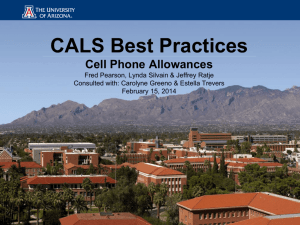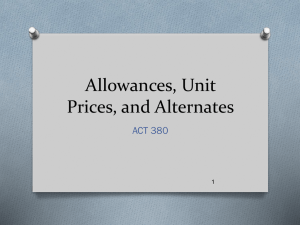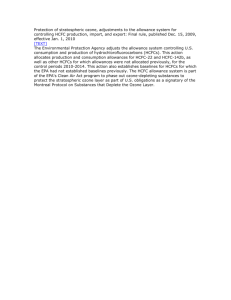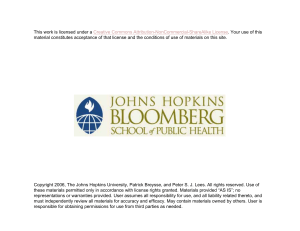ST = NT (1+ allowances)
advertisement
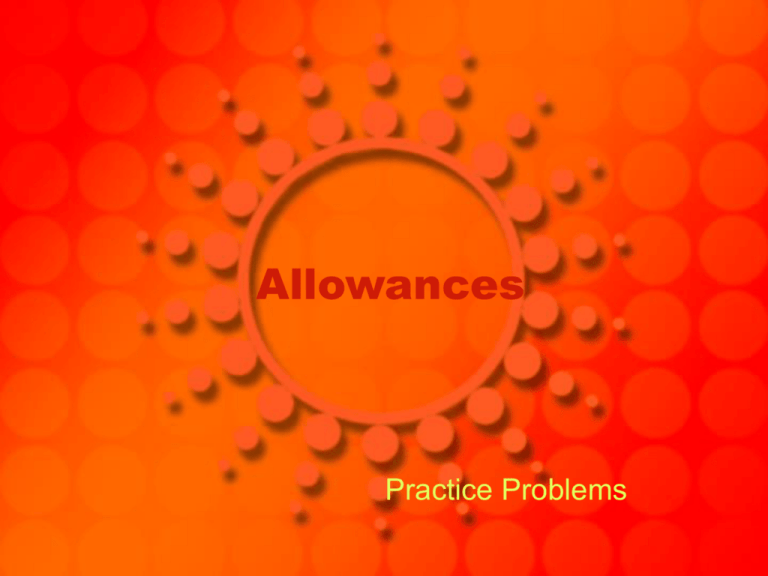
Allowances Practice Problems Example 1 • Suppose you have a fine assembly task – Standing – Requires approximately 300 kCal / hr (based on HR measurement) – NT = 90 cmin. – Additional Considerations include • • • • Illumination – 25 fc in work area Noise – fairly continuous 91 dBA in work area Heat – First hot day of the year, WBGT = 80 °F No significant mental strain, monotony, or repetitiveness. • What is the Standard Time? Example 1 (cont’d) • ST = NT (1+ allowances) • 2 ways to find allowances – Quick & Dirty way • Table 11-2 (ILO Recommendations) – More thorough way • Calculate individual relaxation allowances, RA, for each variable and special allowance factor. ILO Recommendations Table 11-2, Niebel & Frievalds p. 437 Example 1 (cont’d) • More thorough method – Use Table 11-11, p. 453. • Some factors can be found directly from the table – Constant – Posture – Visual Strain • Others must be calculated. Example 1 (cont’d) • Personal needs = 5% (always constant) • Basic Fatigue = 4% (always constant • Posture – standing = 2% – Why isn’t there an option for seated? • Visual Strain – Fine assembly = 2% • Mental Stress, Monotony, Repetitiveness = 0%. Example 1 (cont’d) • Illumination – Looks like a chart lookup, but what are IES subcategories? • Refer to Ch. 6, p. 237, Table 6-2. • Our illumination = 25 fc, or CAT D. • What should our illumination category be? – Do you see “fine assembly” listed? – Should be between “medium” & “extra-fine” assembly. – Should be CAT F, but we are 2 categories below. • From Table 11-11, illumination allowance = 3% Example 1 (cont’d) • Atmospheric Conditions (HEAT) – Workload, W = 300 kcal/hr – WBGT = 80 °F • How do you determine WBGT? – RA = e (-41.5 + 0.0161W + 0.497WBGT) – = e (-41.5 + 0.0161x300 + 0.497x80) – = e (3.09) = 22% – Can also lookup RAL from Fig 6-11, p. 253. • RAL for 300 kcal/hr & WBGT = 80 °F is 48 min/hr – 12 min rest / 48 min work = 25% allowance. Example 1 – (cont’d) • Noise – SPL = 91 dBA • What is SPL – Need to calculate dose for 8 hour day. • • • • • If 90 dBA is 8 hour-100% dose, what about 91dBA? Must find time for 100% dose T = 8 / 2 [(L-90)/5] T = 8 / 2 [(91-90)/5]. T = 6.96 hours is a 100% dose for 91 dBA. D = 8/6.96 = 1.15. – RA = 100 x (D – 1) – = 100 x (1.15-1) – RA = 15% Example 1 (cont’d) • Find Standard Time – ST = NT x (1 + Σ allowances) – ST = 90 cmin x (1+0.05+0.04+0.02+0.03+ 0.02+0.22+0.15) – ST = 90 cmin x (1 + 0.16 + 0.22 + 0.15) » – ST = 90 x (1.53) – ST = 137.7 cmin HEAT NOISE Example 1 - Redesign • As a process engineer, what would be the first things you would want to do to bring the standard time closer to the NT? – The heat allowance is the largest? • It can be reduced to eliminate extra heat fatigue. • How? – The noise allowance is the next largest • What would you do about that one? Measurement • How do you measure… – Illumination? – Heat? – Noise? • For the next 3 labs, you will practice measuring these three environmental factors – This week, we will begin with noise. • You will write one report that considers the impact of these three factors on work performance – based on the data you will collect – AND, based on some homework problems you will receive in lab. Homework • Work the following problems – Ch. 11 – Prob #1, 2, 3, 5 & 7. • Due one week from today. • This is in addition to the homework you will receive in lab today!! – But, there’s no report due next week.



